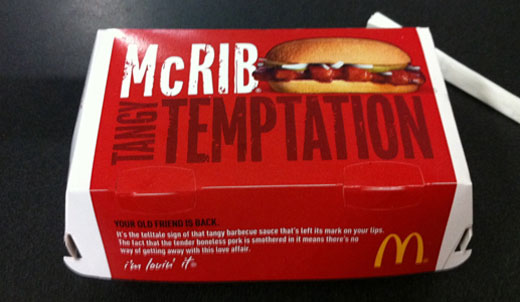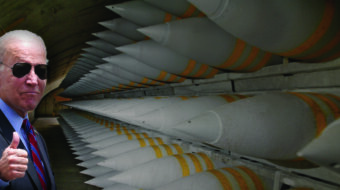
The famous McRib pork patty has once again made a brief appearance at a McDonald’s near you. For a brief three weeks, October 24 to November 14, the elusive pork patty was available to the masses of gustatory-challenged carnivores who have become addicted to its unique combination of nutritionally disastrous chemical toxins.
From its first appearance, 1981-1985, (occasioned by a dearth of chickens available for nuggetivation) the McRib has been on and off the McDonald’s menu several times. It was widely available after being reintroduced in 1989– until removed again in 2005. Since then it has had a sporadic career in different parts of the McDonald’s Empire (except for Germany where it has always been available due to their unquenchable appetite for all things porky). But in the last couple of years the Empire has begun to make it available nationwide but only for a few weeks at a time with long periods between appearances.
What is the nature of this pork patty? It has no ribs in it so its name is somewhat misleading. Like a Hollywood star its real name, McRestructured-Meat-Product, was deemed by its creators too off putting to gain much attraction or many fans. Even McPork-Patty did not seem to have much appeal. But who doesn’t like ribs? And who wouldn’t fall for a juicy plump (at least in its roll) glob of restructured meat product with fake rib indentations slathered in barbecue sauce and introduced as the McRib sandwich (the name that brought it fame)?
But behind that lovely exterior McRib hides a sordid past. Its popularity masks its history of chemical dependence. It cannot show up to perform its culinary wonders unless it has been provided with seventy different chemicals and compounds by its legions of enablers.
It starts life on the slaughterhouse floor of Smithfield Foods which supplies McDonald with the raw meat that will become McRib. This relationship may soon end as the Humane Society of the United States is even now exposing what it calls cruel and inhumane treatment of the animals Smithfield slaughters and is asking for the intervention of the federal government to halt the company’s alleged truly odious practices.
McDonald’s takes this meat – basically pork shoulder mixed with pig tripe (the next door neighbor of chitlins in the pig digestive system), hearts, and scalded pig stomach, technically known as “restructured meat (pork) product.” However, due to the company’s friends in Congress, this is listed for the public as “pork.” It’s mashed up into a mush to which about three dozen chemicals and compounds are mixed (including sauce and bun) to make it appear presentable and salable to the public. Since you can imagine what this slop might taste like in its natural state, it needed all sorts of artificial flavors and colors mixed into it, and its sauce and bun, before anyone could be lured into embracing it with the love it so richly does not deserve.
One of its flavors comes from the 980 mg of salt it gets along with 26 grams of fat, including trans fat, and 41 percent of your daily maximum of cholesterol. McRib is now ready to weigh in at 500 calories, slightly less than the lead star at McDonald’s, the Big Mac. And, if you find McRib’s bun nice looking, one of the reasons is it is bleached with azodicarbonate, a chemical more commonly used in making foamed plastics in shoe soles and gym mats. By the looks of some McRib’s fans, azodicarbonate may be the closest they will ever get to a gym.
Why the periodic appearance of McRib? I don’t know, might it have something to do with the fact that different states have different times of expiration for their statutes of limitation on personal injury law suits?
In any case, the McRib is once again in semi-retirement. If we are lucky, maybe by next Thanksgiving McDonald’s will have McTurkey ready for us.
Photo: justgrimes CC BY-SA 2.0

MOST POPULAR TODAY

‘Warning! This product supports genocide’: Michigan group aims to educate consumers

Ohio: Franklin County treasurer attends Netanyahu meeting, steps up Israel Bond purchases

“Trail of Tears Walk” commemorates Native Americans’ forced removal

After months of denial, U.S. admits to running Ukraine biolabs

Hold the communism, please: SFMOMA’s Diego Rivera exhibit downplays artist’s radical politics






Comments